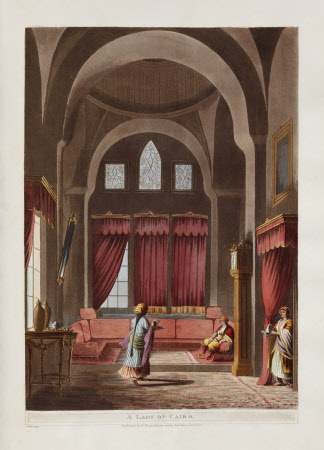Views in Egypt, : from the original drawings in the possession of Sir Robert Ainslie, taken during his embassy to Constantinople, / by Luigi Mayer: engraved by and under the direction of Thomas Milton: with historical observations, and incidental illustrations of the manners and customs of the natives of that country.
Luigi Mayer (1755-1803)
Category
Books
Date
1801
Materials
Place of origin
London
Order this imageCollection
Anglesey Abbey, Cambridgeshire
NT 3042096
Summary
Luigi Mayer, Views in Egypt from the Original Drawings in the Possession of Sir Robert Ainslie, Taken During his Embassy to Constantinople, London: printed by T. Bensley for R. Bowyer, 1801-4. Binding: Nineteenth-century half calf; marbled paper over boards; six false bands; black spine label: 'Views in Egypt'; brown speckled edges.
Full description
The Scots diplomat Sir Robert Ainslie (1729/30-1812) became British ambassador in Constantinople in 1775. It was a sensitive time for Anglo-Turkish relations. Just five years previously, in 1770, Catherine the Great's Baltic fleet had sailed round Europe to annihilate the Ottoman navy at the Battle of Çeşme Bay, and the Sublime Porte was well aware that the Russian ships had revictualled in England during the course of their epic voyage from St Petersburg to the Aegean. But Ainslie enjoyed good relations with his Turkish hosts; in time, as London's ‘St. James’s Chronicle’ noted in 1790, he became ‘strongly attached to the manner of the people. ‘In his house, his garden, and his table’, it explained, ‘he assumed the style and fashion of a Musselman of rank; in fine, he lived ‘en Turk’’. While in Constantinople, Ainslie combined his official duties with collecting Byzantine and Ottoman coins and antiquities, and he also commissioned a collection of drawings from Italian artist Luigi Mayer (1755-1803). Mayer was a painter and watercolourist, now mostly remembered for his association with Ainslie, though he also produced oils and gouaches, chiefly of scenes in southern Italy and the Levant, monuments to what a later generation would call – with varying degrees of approbation – Orientalism. Text adapted from Mark Purcell's entry in ‘Treasures from Lord Fairhaven’s Library at Anglesey Abbey’, National Trust, 2013, cat. 19, pp. 80-81.
Bibliographic description
[4], 102, [2] p., [48] leaves of plates : col. ill. ; fol. Plates coloured. Provenance: Twentieth-century armorial bookplate, Signed G.S.24 and dated 1924: Urban Huttleston Rogers Broughton [i.e.: Urban Huttleston Broughton (1896-1966)]. Binder's ticket on front pastedown: 'B. Hunt … 75, High Street, Birmingham'. Binding: Nineteenth-century half calf; marbled paper over boards; six false bands; black spine label: 'Views in Egypt'; brown speckled edges.
Provenance
Acquired by Huttleston Rogers Broughton, 1st Lord Fairhaven (1896-1966) and then bequeathed by him to the National Trust with the house and the rest of the contents in 1966.
Makers and roles
Luigi Mayer (1755-1803), artist Thomas Milton, engraver (printmaker)
References
Mark Purcell, William Hale and David Person, Treasures from Lord Fairhaven’s Library at Anglesey Abbey, Swindon: National Trust; London: Scala Arts & Heritage Publishers, 2013., pp. 80-1
